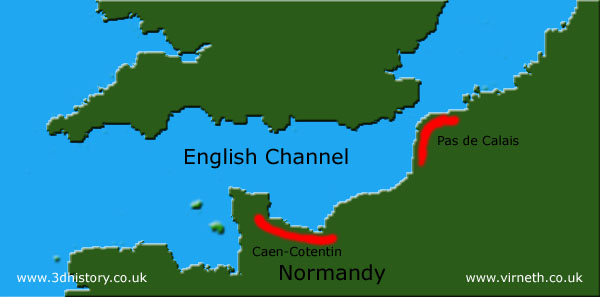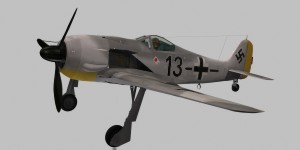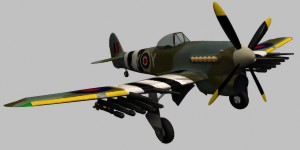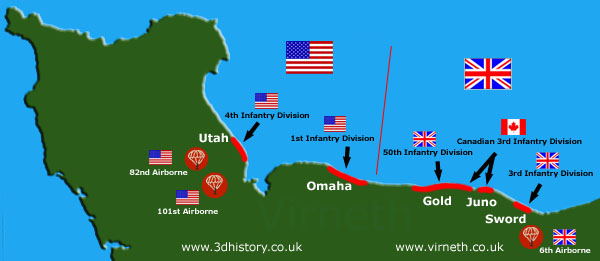The Second World War - Operation Overlord - World War Two - Operation Overlord
Operation Overlord
Operation Overlord was the code name given to the project dealing with the Invasion of occupied Europe by the Allied nations in World War Two. The objective of Overlord was to secure a beachhead on the Continent from which further offensive operations could be developed.
The beachhead was to include sufficient port facilities to maintain a force of about twenty six to thirty divisions with enough surplus capacity to enable reinforcements to be brought ashore at the rate of three to five divisions per month. It was assumed that, upon capture, ports in the beachhead area would be seriously damaged and blocked, and that supplies and replacements would have to be landed onto the beaches over a significant period.
An initial study identified the Pas de Calais and the Caen-Cotentin beaches in Normandy as the best suited for the landing areas, having sufficient capacity for the expected level of traffic. The Caen-Cotentin area also had the advantage of being sheltered from the prevailing Atlantic winds by the Cotentin peninsular.
After considering the advantages and disadvantages of the two alternatives it was decided that the Caen-Cotentin beaches in Normandy offered the most favourable chances for a successful operation. The Pas de Calais was the closest to mainland Britain but was heavily defended and had limited opportunities for extending the beachhead, which would have entailed negotiating the numerous waterways of Northern France and the Low Countries. The Caen area, however, was much less well defended and had fewer airfields from which the Luftwaffe could challenge the invasion. There was also much more scope for exploiting the beachhead, and the type of country did not promote the use of the Panzer divisions in a counter attack.
D-day
D-Day was the codename assigned to the actual day of the invasion. The initial target date was to be the 14th May 1944 but eventually it was planned for the 5th June. Due to bad weather D-Day was postponed 24 hours and the invasion subsequently began on the 6th June 1944.
Briefly, the invasion began with the assembling of the vast armada of ships necessary to carry the invasion force and with the dropping of airborne troops to secure and protect the flanks of the landing area. Then, at about 06:30 on the 6th June, the seaborne assault commenced.
Five Infantry divisions began the landings onto the designated beaches: Utah, Omaha, Gold, Juno and Sword. This intense activity was the culmination of a great deal of planning, preparation, deception and training over the previous few years.
Planning
Created in June 1942, Supreme Headquarters Allied Expeditionary Force (SHAEF) was the organisation given the task of planning the invasion. The American general Dwight D. Eisenhower assumed command of this organisation in January 1944. The initial plan was prepared by the British Lieutenant General Frederick Morgan, the Chief of Staff to the Supreme Allied Commander (COSSAC), and called for the landing of three divisions on the Cotentin peninsular.
Eisenhower's immediate staff were British: Admiral Bertrand Ramsey, the Naval Commander, Air Marshall Arthur Tedder, the Air chief and Field Marshall Bernard L. Montgomery in charge of the ground troops. It was Montgomery who immediately called for an increase in the scale of the operation, arguing for five divisions, two American, two British and one Canadian, landing on the beaches supported by an air drop of three divisions to secure the flanks of the beachhead. The proposed changes were accepted and duly incorporated into the plan. The plan now demanded the build up of a massive amount of material, requiring over 5000 ships and landing craft to transport about 200,000 vehicles.
Focke-Wulf 190A - Oberst Josef Priller JG 26 - France 1944.
Preparation
Aside from the weather, it was recognised that the biggest threat to the success of the operation was the German Air Force. During the invasion the Allied air forces would be at a tactical disadvantage, operating much further from their home bases than the Luftwaffe. To secure air superiority over the landing beaches it was vital that the Luftwaffe was prevented from operating effectively. Accordingly plans were put into operation to reduce the capabilities of the Luftwaffe. Bombing raids were mounted to disrupt the supply of material, air battles were staged to draw the Luftwaffe into combat with the intention of reducing it's combat strength , and air raids, targeting airfields, military installations and centres of communications, were effected along the whole of the French North West coast to spread out the Luftwaffe's resources.
Hawker Typhoon 247 Squadron, Colombelles, June 1944
To protect the transport fleet mines were laid on both flanks of the assault area and operations against E-boats and U-boats in the Channel and Bay of Biscay were intensified. Minesweeping in the Channel was not carried out until the day before D-Day to discourage the Germans from laying mines in this area.
The operation was to commence with the assembling of the naval assault forces, between the Thames estuary and Falmouth, about six weeks prior to the actual invasion. The assembly was to be completed by D - 7. Additional Naval forces would be assembled in the Channel just before the invasion.
Intelligence and Deception
The allies carried out numerous programs to determine the enemy strength and positions, fool the German High Command and keep the location of the landings secret . The three major programs were Ultra, Fortitude and Double-Cross.
Set up by Britain's Secret Service at Bletchley Park in 1939, Ultra was the project dedicated to the gathering of information from German communications. The information obtained allowed the Allies to build up a very detailed picture of the German military dispositions and order of battle. The part played by Ultra was critical in ensuring the success of Overlord.
Fortitude was the operation aimed at deceiving the Germans into thinking that the invasion was to take place elsewhere. It involved the creation of fictitious units and whole camps of false tanks, trucks, bombers, boats and other equipment made from rubber, wood and other cheap materials.
The Double-Cross system was implemented to support the Fortitude operation by using a network of double agents, German agents persuaded to work for the Allies, to feed false information to their German controllers. What resulted was the widespread re-deployment of German troops into areas like Norway and the South of France that were utterly remote from the actual intended landing site.
Other intelligence gathering operations included the use of midget submarines and navy divers to survey the beaches. The French resistance also played a vital role in assessing the extent and effectiveness of the beach defences and garrisons.
Training
The troops were trained thoroughly in some of the most realistic situations ever attempted. Real ammunition was used and the locations were chosen to match the actual locations that the troops would operate in. Troops learned how to operate as teams to deal with specific types of obstacles, such as gun emplacements, trenches and pill boxes. Specialist units were trained to destroy specific targets and take important objectives such as the gun emplacement at the Pointe du Hoc.
After the Dieppe raid of August 1942 it was obvious that an assault against a port would be futile. At Dieppe the infantry had landed first followed by the supporting Armour. When the Armour did land it failed to negotiate the sea wall successfully. The result was a fiasco, the unsupported Infantry were pinned down on the beaches and were shot to pieces by the defending Germans.
The Assault
As the troops started to embark on the 5th bad weather set in and the decision to delay the operation by 24 hours was made, requiring the recall of vessels already at sea. On the 6th a gap in the weather was forecast and after some deliberation Eisenhower made the decision to go ahead.
WACO - CG4A Hadrian Glider
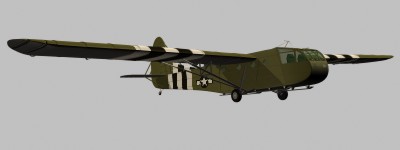
The fleet of over 6,000 craft assembled in an area of the channel known as Piccadilly Circus and followed a path that reduced the chance of the Germans correctly forecasting the final destination. Ten channels, two for each beach, were cleared of mines. One channel was for the fast traffic and one was for the slow traffic. Overhead more than 800 aircraft carrying paratroops or towing gliders headed for the landing zones in Normandy.
The British 6th Airborne Division landed in a combined parachute and glider operation and were tasked with securing the left flank of the beachhead. At just after midnight Major John Howard's force, D company, 2nd Oxfordshire and Buckinghamshire Light Infantry, was the first to land on French soil and promptly captured the bridges over the Caen canal and River Orne for the loss of only two men.
The Normandy landscape was a patchwork of fields surrounded by high hedges known as the Bocage. This was ideal defensive country and was a feature that was used to great advantage by the defending Germans.
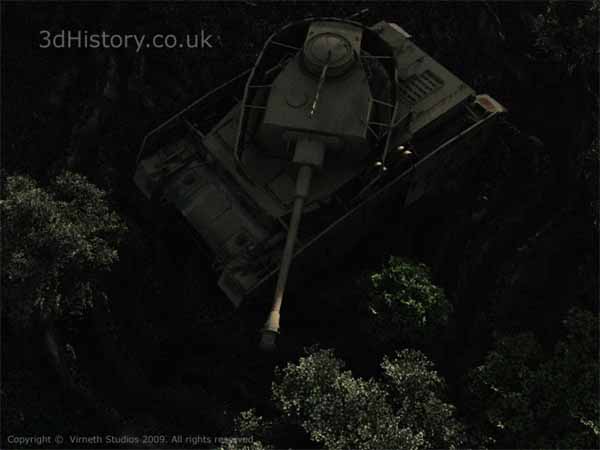
The Merville battery was silenced by 150 men of the 9th Battalion for the loss of half the attacking force. The rest of the 6th Airborne Division continued to land during the night and succeeded in destroying 5 bridges over the River Dives to impede the movement of German troops towards the invasion area. By 13.00 hours on the 6th the paratroops were joined by elements of the 1st Commando Brigade led by Lord Lovat. The 6th Airborne had taken heavy losses but had achieved all of its main objectives.
Left - The Sten gun - used by the British paratroops
The American 82nd and 101st Airborne divisions were tasked with securing the area behind the Utah beach and to prevent the Germans from reinforcing the troops in that area. The drop went badly, the transport aircraft encountered a cloud bank just before the drop zone, which, combined with anti-aircraft fire, dispersed many of the planes and subsequently the paratroops were dropped all over the place.
The area designated as the drop zone had been deliberately inundated with water and many men, weighed down with a heavy load of equipment, were drowned as they landed in several feet of water . Although the American units were scattered all over the Cotentin peninsular, they assembled into make shift units and began to organise themselves.
Sainte Mere-Eglise was a key objective for the 82nd Airborne. Unfortunately sections of the 505th Parachute Infantry were dropped directly onto the village. A fire had been started by tracer illuminating the descending troops who were all either killed or captured. For some reason the defending Germans went back to bed after the engagement so that when another unit of about 180 Americans, led be Lt. Col. Ed Krause, arrived later they managed to secure the village relatively easily.
By dawn on the 6th the objectives of the 82nd and 101st Airborne divisions had not been taken. However, due to all the problems and the dispersal of the airborne troops, the Germans could not establish any pattern or reason for the drop and therefore could not mount an effective response. This ironically went in the Americans favour and actually benefited the seaborne troops landing at Utah beach as the German defenders were busy chasing the airborne troops all over the Cotentin peninsular.
German MG42 Machine gun capable of firing 1200 rounds per minute
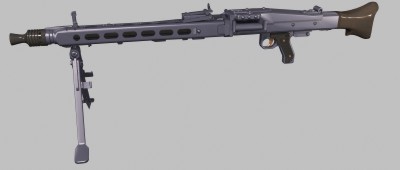
Beach assault
The seaborne units started their assault at about 06:30 on June 6th. The five landing beaches were split into two sectors: Utah and Omaha in the American sector and Gold, Juno and Sword in the British Sector. The American 4th Infantry Division landed on Utah on the right flank and overcame light resistance. The assault on Omaha beach by the American 1st Division did not go well and came close to failing. The British 50th Infantry Division, Canadian 3rd Infantry Division and the British 3rd Division, attacking Gold, Juno and Sword respectively, all made good progress.
By June 12, after some serious fighting around Carentan, the landing area had been extended to form a continuous beachhead nearly 15 miles deep around Bayeux.
Supplies
Two artificial harbours, called Mulberries, intended as the primary method to facilitate the movement of supplies from ship to shore until the port of Cherbourg was available, were floated into position as soon as the beaches were secure and were operational by D plus 12 (18th June).
One harbour, Mulberry 'A', serving the American forces, was located off Omaha beach. The other, Mulberry 'B', the British harbour, was located off Arromanches at Gold beach. Each Mulberry had an outer breakwater formed partly by huge concrete caissons called 'Phoenixes' and by old ships, called 'Gooseberries', deliberately sunk in place. Piers, arranged perpendicular to the beach, were terminated with floating platforms called 'Spuds' that were jacked up and down on four legs with the rising and ebbing tide.
On June 19th, however, a violent storm started and over the next few days wrecked the American harbour and severely damaged the British one. In view of the damage sustained to the American harbour it was decided not to repair it. Instead parts were salvaged from it to repair the British harbour. The Americans reverted to landing supplies directly onto the beach, which proved to be very efficient.
Hobart's Funnies
The Dieppe raid of August 1942 had highlighted the fact that specialised equipment would be required to overcome the initial obstacles on the beaches. The Allies response to this was to create the 79th Armoured division, commanded by Major General Sir Percy Hobart. The 79th was charged with developing special purpose armoured fighting vehicles that could perform a variety of tasks, clearing the way for the Infantry.
Amongst the numerous type of vehicles were the Duplex Drive 'swimming' tanks. In addition to the normal tracks there were two propellers, driven by the main engines, that could propel the tanks through the water at a brisk walking pace. The tanks were kept afloat by a 9ft high canvas hull that was raised around the tank. The canvas hull could be lowered in seconds once the tank was on the beach. The Americans launched 64 duplex drive Sherman tanks off Omaha beach but most of them sank in rough seas, only 5 reaching the beach to support the 1st Infantry Division. The 79th Armoured Division launched 40 DD Churchill tanks off Sword beach. Thirty three managed to reach the shore and gave invaluable support to the Infantry there.
Other types of vehicles were used for clearing mines, laying temporary road surfaces, filling in craters and recovering damaged or stuck equipment. Armoured ramps were turret less tanks with ramps fore and aft that could be extended to form a pathway up steep embankments or seawalls. There were bridge layers that could lay an assault bridge spanning gaps of up to thirty feet.
The contribution of these specialised vehicles to the success of the operation was immense.
Conclusion
Operation Overlord was considered to be highly successful in that it achieved its objective of establishing a lodgement area on the continent suitable for launching future operations. The cost had been high, particularly amongst the airborne troops and the American 1st division on Omaha beach, and some key objectives had not been taken, notably Caen, but overall the Allies had done what they had set out to do several years earlier. There was still a great deal to do to finish the job and overthrow the Nazi empire but everyone knew that, from D-day onwards, it was just a matter of time.

